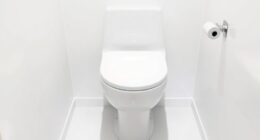Do sitz baths actually lead to UTIs?
We’ve all heard about the benefits of sitz baths for soothing and healing various conditions, but could they potentially lead to urinary tract infections?
In this article, we’ll delve into the science behind UTIs and how sitz baths work.
We’ll also explore the possible connection between sitz baths and UTIs, as well as provide tips on reducing the risk of developing one.

So, let’s get to the bottom of this burning question!
Key Takeaways
- UTIs can be caused by bacteria entering the urethra and traveling to the bladder.
- Risk factors for UTIs include poor bathroom hygiene, sexual activity, a weakened immune system, and certain medical conditions.
- Sitz baths can provide relief and promote healing for conditions like hemorrhoids, anal fissures, and postpartum recovery.
- Prolonged or frequent sitz baths can disrupt the natural balance of bacteria, increasing the risk of UTIs.
Understanding UTIs and Their Causes
In this article, we’ll explore the causes of urinary tract infections (UTIs) and gain a deeper understanding of how they occur.
UTIs are primarily caused by bacteria entering the urethra and traveling up into the bladder. Several factors can increase the risk of developing a UTI, such as poor bathroom hygiene, sexual activity, a weakened immune system, and certain medical conditions.
To prevent UTIs, it’s essential to practice good hygiene, including wiping from front to back after using the toilet and urinating before and after sexual activity. Drinking plenty of water and avoiding irritating substances like caffeine and alcohol can also help prevent UTIs. Additionally, some home remedies, such as drinking cranberry juice or taking probiotics, may have a preventative effect.

Now, let’s transition to the subsequent section and explore how sitz baths work.
How Sitz Baths Work
Let’s dive into how sitz baths function to provide relief and promote healing.
Sitz baths are a therapeutic technique that involves sitting in warm water up to the hips. This simple yet effective method offers a range of benefits for various conditions, including hemorrhoids, anal fissures, and postpartum recovery.
The warm water in a sitz bath helps to increase blood flow to the pelvic area, reducing inflammation and promoting healing. It can also provide relief from pain, itching, and discomfort. The technique works by relaxing the muscles in the pelvic floor, which can help with conditions like pelvic pain and muscle spasms.

To perform a sitz bath, fill a specially designed basin or bathtub with warm water and sit in it for about 15 to 20 minutes, two to three times a day. Make sure the water isn’t too hot to avoid scalding or irritation. Adding Epsom salts or other soothing ingredients can enhance the therapeutic effects.
Potential Link Between Sitz Baths and UTIs
There is a potential link between sitz baths and UTIs. While sitz baths have been widely used for postpartum recovery due to their various benefits, it’s important to be aware of the potential risk of developing a urinary tract infection (UTI) when using this method.
Here are three key factors to consider:
- Duration and frequency: Prolonged or frequent sitz baths can disrupt the natural balance of bacteria in the genital area, increasing the risk of UTIs.
- Contamination: If the water used in the sitz bath isn’t clean or if the bath equipment isn’t properly sanitized, it can introduce harmful bacteria, leading to UTIs.
- Personal hygiene: Poor personal hygiene practices, such as not washing hands before and after using the sitz bath, can also contribute to the development of UTIs.
To minimize the risk of UTIs while reaping the benefits of sitz baths for postpartum recovery, it’s important to follow certain precautions and guidelines.

Tips for Minimizing the Risk of UTIs With Sitz Baths
To minimize the risk of UTIs when using sitz baths, we can take certain precautions and follow guidelines. Preventing UTIs is essential to maintain our overall health and well-being. Here are some important sitz bath precautions to keep in mind:
- Maintain proper hygiene: Before and after taking a sitz bath, it’s crucial to thoroughly clean the area to prevent the spread of bacteria.
- Use clean water: Ensure that the water used for the sitz bath is clean and free from any contaminants.
- Avoid using harsh soaps or chemicals: Using gentle, fragrance-free soaps or natural remedies can help prevent irritation and decrease the risk of UTIs.
When to Seek Medical Advice
If we experience any concerning symptoms or complications after using a sitz bath, it’s important to seek medical advice promptly. While sitz baths are generally safe and beneficial, there are instances where medical attention may be necessary.
Here are three situations when seeking medical advice is recommended:
- Persistent or worsening symptoms: If symptoms such as pain, itching, or burning persist or worsen after using a sitz bath, it’s important to consult a healthcare professional. They can evaluate the underlying cause and recommend appropriate treatment.
- Development of new symptoms: If new symptoms such as fever, chills, or blood in the urine arise after using a sitz bath, it may indicate a urinary tract infection (UTI). Prompt medical attention is crucial for diagnosis and treatment.
- Recurrent UTIs: If you have a history of recurrent UTIs and experience symptoms after using a sitz bath, it’s advisable to consult a healthcare provider. They can provide guidance on UTI prevention strategies and recommend further evaluation if necessary.
Frequently Asked Questions
Are There Any Alternative Methods to Treat Urinary Tract Infections (Utis) Without Using Sitz Baths?
There are alternative treatments for UTIs that don’t involve sitz baths. Natural remedies for urinary tract infections, such as drinking plenty of water, taking cranberry supplements, and using probiotics, can help alleviate symptoms.

Can Men Also Benefit From Sitz Baths for UTI Relief?
Yes, men can also benefit from sitz baths for UTI relief. Sitz baths have been found to provide relief from UTI symptoms for both women and men. It is a non-invasive alternative to antibiotics for UTI relief.
How Long Should I Take a Sitz Bath in Order to Effectively Prevent Utis?
To effectively prevent UTIs, we recommend taking sitz baths for 10-15 minutes, 2-3 times a day. Research shows that this duration and frequency can significantly reduce the risk of UTIs.
Can Sitz Baths Cause Any Other Complications or Side Effects Besides Utis?
Sitz baths can potentially cause complications and side effects besides UTIs. It is important to be aware of potential risks such as skin irritation, allergic reactions, and changes in blood pressure.
Is It Safe to Use Bath Salts or Other Additives in a Sitz Bath for UTI Treatment?
Using bath salts or other additives in a sitz bath for UTI treatment can be safe if done properly. It’s important to follow guidelines and consult a healthcare professional to ensure the best and safest outcome.

Conclusion
In conclusion, while sitz baths can provide relief for various conditions, there’s a potential link between sitz baths and UTIs.
It’s important to take precautions to minimize the risk of developing a UTI, such as using clean water, avoiding excessive heat, and maintaining proper hygiene.
Remember, an ounce of prevention is worth a pound of cure, so it’s essential to prioritize your urinary health when using sitz baths.










